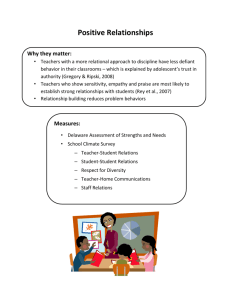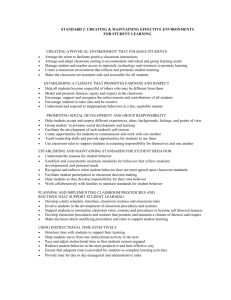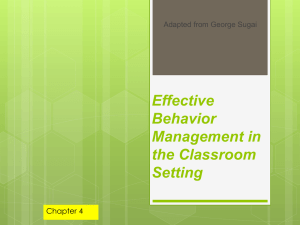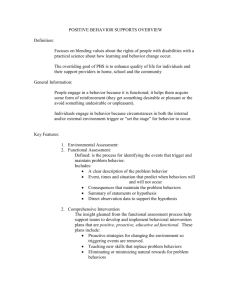PBS in the Classroom: Evidence-Based Practices in Classroom
advertisement
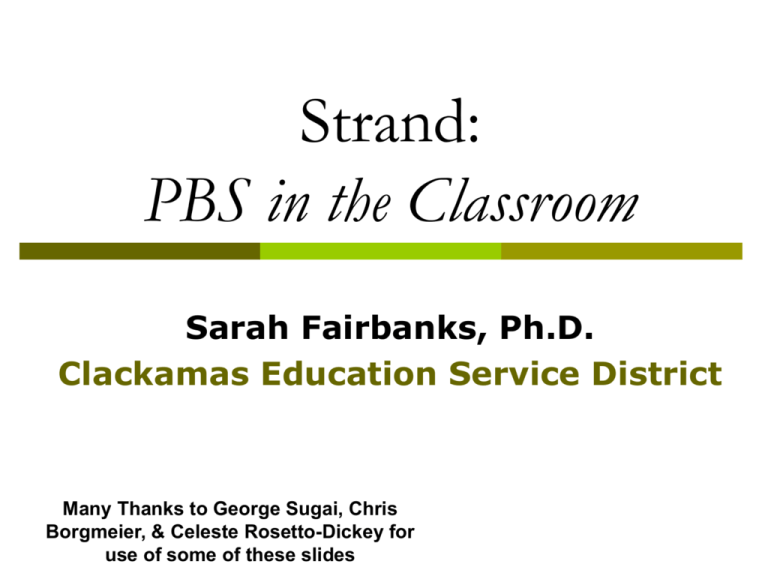
Strand: PBS in the Classroom Sarah Fairbanks, Ph.D. Clackamas Education Service District Many Thanks to George Sugai, Chris Borgmeier, & Celeste Rosetto-Dickey for use of some of these slides Classroom Strand Focus Classroom Non-classroom • Smallest # • Evidence-based Family • Biggest, durable effect Student Strands One focus for the year vs. several topics Come to the same training in the winter and spring Next trainings: 1/15, 4/9 One focus for the year vs. several topics Part of ongoing school-wide PBS development **Focus this year on staff development Strand- PBS in the Classroom This is the 1st of 3 of trainings on: 1st Assessing and progress monitoring staff classroom management skill & impact on behavior 2nd Developing 1-2 lessons to support staff related to classroom management Why? To identify areas of strength & weakness for staff related to classroom management. Address weaknesses by regularly teaching strategies to improve knowledge and expertise To improve class-wide behavior across the school Not a “train and hope” focus Improve teacher satisfaction Today’s Goals/Objectives Share Review Team Implementation Checklist/A.P./Roles Part 1 of classroom training series Self-assessments Review 2 areas of classroom management Complete 1st staff training You should leave today with Team planning Team checklist completed, A.P. started, Roles identified 1 Draft lesson plan for PBS in the classroom 1+ Draft dates to do the lesson plans throughout the year Plan for presenting the lessons Ok??? Sharing As a large group 1-2 accomplishments 1-2 Goals Supporting Social Competence & Academic Achievement 4 PBS Elements OUTCOMES Supporting Decision Making Supporting Staff Behavior PRACTICES Supporting Student Behavior CONTINUUM OF SCHOOL-WIDE INSTRUCTIONAL & POSITIVE BEHAVIOR SUPPORT FEW ~5% ~15% SOME Primary Prevention: School-/ClassroomWide Systems for All Students, Staff, & Settings ALL ~80% of Students Tertiary Prevention: Specialized Individualized Systems for Students with High-Risk Behavior Secondary Prevention: Specialized Group Systems for Students with At-Risk Behavior CONTINUUM OF SCHOOL-WIDE INSTRUCTIONAL & POSITIVE BEHAVIOR SUPPORT Phase 1: School-/ClassroomWide Systems Phase 1A: Task 1. Clear Expectations 2. Expectations Taught 3. Team Structure for implementation Example Benchmark 1. ?? 2. ?? 3. ?? Adapted from Dale Myers, Ph.D. Teaching Who teaches? How do you teach? I do it, we do it, you do it I show the examples and non-examples You show examples only When do you teach? Classified & Certified side by side Regular Schedule throughout the year Based on date, incidental/surprise too Where do you teach? In the setting Team Structure Meeting regularly? Review data each mtg.? Every staff meeting, after every training—we train the staff! Each member has a role? Things get done & we respect each other’s time Regular training and feedback solicited from staff? Key players kept in the loop on PBS Adhere to time limits? The Big 5 Follow agenda? Minutes dispersed? Every other week/ 1x a month Data manager, facilitator, note-taker Action plan completed/followed? CONTINUUM OF SCHOOL-WIDE INSTRUCTIONAL & POSITIVE BEHAVIOR SUPPORT Phase 3: Tertiary Support Phase 2: Secondary Prevention Phase 1: School-/ClassroomWide Systems Phase 1B: PBS to all staff Phase 1C: PBS in the classroom Phase 1A: Task 1. Clear Expectations 2. Expectations Taught 3. Team Structure for implementation 4. Systems to respond to appropriate behavior 5. Systems to respond to inappropriate behavior 6. Systems to track behavior/perceptions Example Benchmark 1. ?? 2. ?? 3. ?? 4. Recognition system 5. Correction System 6. Fidelity, Outcomes Adapted from Dale Myers, Ph.D. Team Activity #1 Complete Team Checklist online or paper— Begin completing yearly action plan Based on team checklist Complete PBS roles worksheet Questions: Where are we in the PBS process? What’s next? Are we sustaining what we started? Are we evolving what we started? School A School A What do Effectively Managed Classrooms look like? What are students doing in them? Where Did Students Get These Behaviors? Research in Ineffective Classrooms (e.g., Wehby, Shores, Symmons, 1995; etc., Wehby, Dodge, Valente, & CPRG, 1993; Shores et al., 1993) Low rates of instructional interactions (ISW). Extremely low rates of praise…more than 2x as many “–” as “+” for the most needy When interactions occur, they were non-academic. Increased levels of inappropriate student behavior leads to fewer instructional interactions with students. Correct academic responses by a student did not occasion teacher praise above chance levels. Inconsistent distribution of attention towards “–” vs. “+.” Compliance to a command generally resulted in the delivery of another command Common Mistakes Students know what is expected of them 5:1 Ratio not employed Punishing students for failure to exhibit a behavior that was not taught Get tough! Expectations not really/explicitly taught Absence of clear rules Vaguely stated rules Research is clear—ineffective strategy: agression etc. Mayer, 1995; Mayer & Sulzar-Azaroff, 1991; Skiba & Peterson, 1999 Instructional minutes does not = effective instruction—lack of instruction! (Christenson et al, 1989; Rosenshine & Stevens, 1986) So, What is Classroom Management? Behavior Management Are you ready for PBS in the classroom focus? Your school has been implementing PBS w/ fidelity, phase 1A-B > 60% of referrals from the classroom Link to school-wide PBS is limited Commitment for PBS classroom support PBS team and admin. And teachers are saying… Help, I have all red zone students!! Classroom Support or Referral/discipline occurring w/ multiple students Same students have fewer concerns in alternate settings Individual Student Support Couple of students repeated concerns Few concerns w/ other students in class Concerns w/ students cross multiple settings How Can You Tell? Review Referral data: # of referrals per student, # of referrals per time of day…as in the next slide Example Classroom Data Referrals Students So, now what? - We have several teachers with classroom systems that are not working, students engaging in lots of inappropriate behavior, oh & referrals are on the rise too… Non-examples - Purchase & distribute classroom management curriculum/book - Discuss at faculty meeting - Bring in CM expert for next month’s ½ day inservice What is likelihood of change in teacher practice? (Sugai, 2006) Instead: School-wide Game Plan Let’s create a plan: Effective classroom management begins early Staff/team/admin on-board: Use data to justify PBS Team focus: leads system-wide support at classroom level First, Identify areas of concern across teachers, using a self-assessment Second, create schedule and plan to provide professional development, w/ brief lessons/activities for all staff Third, progress monitor & follow-up: Plan to complete 3-4 times per year w/ subsequent support Fall/Winter/Spring Classroom-Management Self-Assessment Evidence Based Practices in Classroom Management: Self-Assessment 1. Maximize structure in your classroom. 2. Establish, teach, prompt, monitor, & review a small number of positively stated expectations. 3. Actively engage students in observable ways. 4. Establish a continuum of strategies to acknowledge appropriate behavior. 5. Establish a continuum of strategies to respond to inappropriate behavior. (Simonsen, Fairbanks, Briesch, & Myers Sugai, 2008) Team Activity #2 Complete Classroom Management selfassessment: The same one in your team Identify: 2 Strengths and 2 areas of focus for your team Select a date to have your staff complete the Classroom Management self-assessment Determine how you will administer the assessment Make sure staff understand its not evaluative & is anonymous Encourage honest evaluation Explain how the data will be used to provide targeted staff development and support Evidence Based Practices in Classroom Management: Self-Assessment 1. Maximize structure in your classroom. 2. Establish, teach, prompt, monitor, & review a small number of positively stated expectations. 3. Actively engage students in observable ways. 4. Establish a continuum of strategies to acknowledge appropriate behavior. 5. Establish a continuum of strategies to respond to inappropriate behavior. (Simonsen, Fairbanks, Briesch, & Myers Sugai, 2008) 1. Maximize structure in your classroom. Predictable Classroom Routines/Activities Teacher routines: volunteers, communication, planning, etc. Student routines: personal needs, transitions, working in groups, getting, materials, homework, etc. Which routines are most problematic? Low Risk Activities: Homework distribution and discussion Star of Week/Super Scientist recognition Story Computer Low Risk Routines: Getting organized to go home High Risk Activities Morning routine Recess Library Clean-up/Dismissal High Risk Routines Group work Listening and Following directions Respect-adults and peers Working independently Taking of personal needs Getting organized for the day Identify Routines Needing More Attention Getting Working Trans itions Group s Personal Getting Ready Listening Following Help Indepen d. Needs Organized to go Directions Home Morning Rout ine Langua ge Experience Recess Math Star of the Week PE X X X X X X X X Music X Library Computer X X Science Clean-up/ Dismissal X X Develop A functional layout to your classroom Environmental Design Traffic patterns and furniture density Reduce clutter Define areas for different classroom activities Group areas, work stations, teacher desk Seating arrangements (groups, carpet, etc.) Visual access Teacher supervision Student needs for instructional materials etc. Have you maximized structure in your classroom? Self Assess 1)I Complete item for your classroom (or a teacher with whom you consult) maximized structure and predictability in my classroom. a) I explicitly taught and followed predictable routines. 2 1 0 b) I arranged my room to minimize crowding and distraction. 2 1 0 Action Plan Generate action plan content (observable and measurable behaviors to address deficits) Potential action plan items may include: Describe predictable routine for entering classroom, turning in homework, (or others that are identified as missing) Rearrange furniture to ensure better supervision # Current Level of Performance Enhancement/Maintenance Strategies[1] 1 [1] What? When? How? By When? Evidence Based Practices in Classroom Management: Self-Assessment 1. Maximize structure in your classroom. 2. Establish, teach, prompt, monitor, & review a small number of positively stated expectations. 3. Actively engage students in observable ways. 4. Establish a continuum of strategies to acknowledge appropriate behavior. 5. Establish a continuum of strategies to respond to inappropriate behavior. (Simonsen, Fairbanks, Briesch, & Myers Sugai, 2008) Establish, teach, prompt, monitor, & review a small number of positively stated expectations. First Lesson for Staff— Think about how you would use/adapt materials for your lesson 2. Teach a small number of positively stated expectations. Establish behavioral expectations/rules. Teach rules in context of routines. Prompt students before entering context of concern. Monitor/Actively Supervise students’ behavior in context Review/Evaluate effect of instruction - review data, make decisions, & follow up. Establish Behavioral Expectations/Rules A small number (i.e., 3-5) Positively stated Should match SW Expectations Safe, Responsible, Respectful Establish Behavioral expectations/Rules Operationally define what the rules look like Respect– In line Example: Keep 6 inches between you and the person in front of you Non-example: Don’t touch people, respect space Routine/setting examples: How to enter class and begin to work What to do if you do not have materials What to do if you need help What to do if you need to go to the bathroom What to do if someone is bothering you. How to determine if you are doing well in class Difference teaching formats (TLI) One way to do this is in a matrix format. Expectation/Rule Matrix Routines Transitions Rules Respect Responsibility Remain in Control •Hands to self •Worry about self •Stay in your space •Put materials away •Throw things away that are old •Follow adult directions •Remain quiet Independent Seat Work •Raise hand before talking •Turn in work you are proud of •Make noises in your head •Stay on-task •Do your own work •Keep your supplies in your desk •Sit with 5-6 legs on the floor •Stay in your space Small Group Activity •Listen to each other •Accept each other’s answers •Give eye contact Help with the group work •Use time wisely •Keep objects out of hands •Use materials carefully Teacher- Led Instruction •Give eye contact to teacher •Raise hand before talking •Follow along/be in the right place •Listen to teacher instructions •Take notes •Keep objects out of hands •Sit with 5-6 legs on the floor Designing Classroom Routines Routine Entering Class Desired Behavior Walk in, sit down, start work Obtaining Orient to class teacher, be attention quiet Getting Help ? during seat work Signal Instruction on board ? ? Teach Routine Positive and Negative Examples Rules within Routines Matrix Routines Rules Be Safe Be Respectful Be Responsible Entering Classroom -Signal: Seat Work -Signal: Small Group Activity -Signal: Leaving Classroom -Signal: Team Activity # 3 Begin completing a sample classroom matrix for teachers Determine a date/time to have staff complete the Mapping School-wide Rules to Classroom Routines/Expectations (The Matrix/Grid) How will your team? Who on your team? 1) Will “teach” the matrix and share the relevant ppt slides with staff? 2) Reserve time on the master calendar to facilitate the lessons/conversations Evidence Based Practices in Classroom Management 1. Maximize structure in your classroom. 2. Post, teach, review, monitor, and reinforce a small number of positively stated expectations. 3. Actively engage students in observable ways. 4. Establish a continuum of strategies to acknowledge appropriate behavior. 5. Establish a continuum of strategies to respond to inappropriate behavior. (Simonsen, Fairbanks, Briesch, & Myers Sugai, in preparation) Bringing it back to the Staff Provide staff with time to fill out the selfassessment Complete matrix lesson plan Get data from self-assessment website Review results at PBS meeting Create year plan for classroom management Provide data-based support (brief lessons/activities) Progress Monitor: Complete self-assessment again Repeat Above Steps Classroom Management Checklist Data Summary – February 12, 2008 % In Place 38 In Place Status Full Partial 2 1 10 14 Essential Practices Not 0 2 Classroom Management 1. I acknowledge student positive behavior at least 4 times more often than I acknowledge student problem behavior. 2. Classroom rules & expectations are taught, practiced & positively reinforced. 3. Rate the extent the following transition procedures are taught, practiced & positively reinforced in your classroom. a. Entering the Classroom b. Lining up c. Changing between activities d. Exiting the Classroom 4. Rate the extent the following classroom routines are taught, practiced & positively reinforced in your classroom. a. Start of the day / Beginning class b. Group work c. Independent seat work d. Obtaining materials e. Seeking assistance/help f. End of day/ End of class 5. Attention getting cue/rule taught directly, practiced & positively reinforced 6. Continuous active supervision across settings & activities, including moving throughout setting & scanning 7. Desks/room arranged so that all studetns are easily accessible by the teacher 8. Necessary materials and supplies are accessible to students in an orderly fashion 9. Minor problem behaviors are managed positively, consistently & quickly 10. Chronic problem behaviors are anticipated and precorrected 11. Students are provided with activities to engage in if they complete work before other students in the class Instructional Management 12. Majority of time allocated & scheduled for instruction 69 18 8 0 73 67 27 65 19 16 7 17 7 8 18 8 0 0 1 1 85 35 62 50 46 46 85 22 9 16 13 12 12 22 4 15 9 13 14 13 4 0 2 1 0 0 1 0 73 19 7 0 81 21 5 0 73 19 7 0 62 16 10 0 27 7 19 0 58 15 10 1 88 23 2 1 62 16 10 0 13. 58 15 11 0 14. 19 5 21 0 15. 46 12 14 0 16. 65 17 9 0 17. School-wide = Allocated instructional time involves active academic engagement with quick paced instruction Ask clear questions and provides clear directions for assignments Active academic engagement results in high rates of student success (90%+) Actively involves all/majority of students in lessons, this includes providing activities/instructions to students of varying skill levels Instructional activities linked directly to measurable short & long term academic outcomes 58 % In Place 40 % Partially In Place Adapted by C. Borgmeier from Sugai & Colvin 2% Not In Place Graph Across Teachers 1.00 0.90 0.80 0.70 0.60 0.50 0.40 0.30 0.20 0.10 0.00 1 2 3 4 5 6 7 8 9 10 11 12 13 14 15 16 17 18 19 20 21 22 23 24 25 SW in place MeasOutcomes Allinvolved High ClearDirections AcadEng Max InstrTime Finish activities PreCorrect beh MinorBeh Materials Room Sprvsn AttnCue Routines Transitions ClassrmRules 4:1 ratio Graph Across Areas: 100 90 80 70 60 50 40 30 20 10 0 Team Activity #4 How will your team facilitate your staff… 1) in completing the classroom management self assessment and Support action planning 2) Mapping School-wide Rules to Classroom Behavioral Expectations 3) Reserve time on the master calendar for the lessons 4) Discuss staff development strategies that you think are effective in reaching your staff, what strategies will you use? 5) Share 2 strategies with the group 90 80 70 60 50 40 30 20 10 0 Fe 15 b -F eb 1M ar 6M a 13 r -M a 19 r -M a 27 r -M a 29 r -M ar 3A pr 9A pr 24 -A p 30 r -A pr 3M ay 7M a 15 y -M ay 8- n n Fe b -J a 5- 31 n n n BL -J a -J a -J a -J a Ja n 90 25 18 16 10 8- 100 Baseline TRCR Classroom Mgmt Ms. Bonnor Returns 80 70 60 50 40 30 20 10 0 100 90 80 70 60 50 40 30 20 10 100 0 Ms. Bonnor Returns It’s not just about behavior! STUDENT OUTCOMES Academics Behavior Management If you want it, teach it! You get more of what you pay attention to! On school reform… Kauffman states “…attempts to reform education will make little difference until reformers understand that schools must exist as much for teachers as for student. Put another way, schools will be successful in nurturing the intellectual, social, and moral development of children only to the extent that they also nurture such development of teachers.” (1993, p. 7).

